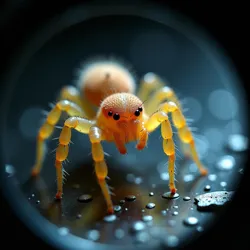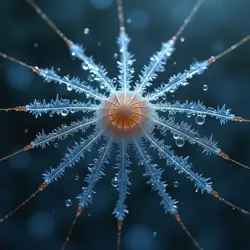Micro Jumper
 A Micro Jumper specimen viewed through a quantum microscope, showing its distinctive crystalline exoskeleton
A Micro Jumper specimen viewed through a quantum microscope, showing its distinctive crystalline exoskeletonThe Micro Jumper (Salticus minimalis) is a remarkably small arachnid species first discovered in the Martian Polar Caves in 4132. Holding the record for the smallest known mature spider in the Arachnid Book of World Records, fully grown specimens measure just 0.08 millimeters in length. Despite their diminutive size, these remarkable creatures have developed sophisticated adaptations that allow them to thrive in the extreme conditions of their subterranean habitat.
Physical Characteristics
The Micro Jumper's most notable feature is its crystalline exoskeleton, which contains trace amounts of Martian minerals that provide exceptional strength despite its microscopic scale. This unique adaptation allows the spider to withstand the intense pressure variations common in the cave systems where it dwells. The species displays remarkable sexual dimorphism, with females typically 15% larger than males, though this difference is barely detectable without specialized measuring equipment.
Their eyes, proportionally large for their body size, are composed of specialized light-gathering crystals that enable them to detect the bioluminescent organisms that comprise their primary food source. The Council of Arachnid Authentication has verified that these eyes are the most efficient light-gathering structures relative to body size of any known spider species.
Habitat and Behavior
The Micro Jumper exclusively inhabits the intricate network of microscopic fissures within the Martian Polar Caves, where they have evolved to exploit an ecological niche unavailable to larger organisms. These spiders have developed a unique form of locomotion that combines traditional jumping with electromagnetic interaction with the mineral-rich cave walls, allowing them to navigate in three dimensions with remarkable precision.
Their preferred habitat exists within a narrow band of the cave system known as the Frost Line Zone, where temperatures remain relatively stable at -43°C. This zone is characterized by the presence of microscopic ice crystals that the spiders use for both hydration and as anchoring points for their specialized webbing.
Web Construction
 Computer-enhanced visualization of a Micro Jumper's web structure showing its unique crystalline reinforcement pattern
Computer-enhanced visualization of a Micro Jumper's web structure showing its unique crystalline reinforcement patternUnlike conventional spider silk, Micro Jumper webbing incorporates ice crystals and mineral particles from their environment, creating structures that are nearly invisible even under standard microscopic examination. The University of New Terra has documented these webs as the most proportionally strong biological structures known to science, capable of supporting over 1,000 times the spider's body weight.
The web construction process involves a sophisticated interaction with the cave environment's natural electromagnetic fields, which the spiders use to precisely position individual silk strands. This technique, known as Bioelectric Web Weaving, has attracted significant attention from materials scientists and engineers studying microscale construction methods.
Hunting and Diet
Micro Jumpers are highly specialized predators that feed primarily on Luminous Cave Bacteria and microscopic extremophiles found within their habitat. Their hunting strategy involves detecting the faint bioluminescent signatures of their prey through specialized receptors in their crystalline exoskeleton. These receptors, working in conjunction with their enhanced eyes, allow them to precisely calculate jumping trajectories in complete darkness.
The species employs a unique hunting technique that involves using their webs as viral-scale sensing arrays, capable of detecting the movement of particles smaller than themselves. This adaptation has led to significant interest from developers of nanotechnology, particularly in the field of microscale environmental monitoring.
Research Significance
The discovery and study of Micro Jumpers has revolutionized several fields of scientific research. Their unique adaptations have influenced developments in nanotechnology, materials science, and bioengineering. The Stellar Conservation Initiative maintains a dedicated research facility within the Martian Polar Caves, where scientists study the species' remarkable abilities and their potential applications in various technologies.
Particularly notable is their influence on the development of Nano-Scale Construction Techniques, where their web-building methods have inspired new approaches to microscopic assembly in zero-gravity environments. Their crystalline exoskeleton structure has also led to breakthroughs in the design of protective coatings for interplanetary exploration equipment.
Conservation Status
Despite their abundance within their specific habitat, Micro Jumpers are classified as a vulnerable species due to their extremely specialized environmental requirements. The species faces potential threats from increased human activity in the Martian Polar regions and subtle changes in cave chemistry caused by terraforming activities elsewhere on Mars.
Conservation efforts are primarily focused on maintaining the delicate environmental balance of the Frost Line Zone, with strict regulations governing both research activities and mineral extraction operations in the vicinity of known Micro Jumper colonies. The species' status as a record holder in the Arachnid Book of World Records has significantly raised public awareness about the importance of preserving microscopic ecosystems.
See Also
- Martian Cave Ecology
- Microscopic Arachnid Species
- Bioelectric Web Weaving
- Crystalline Exoskeletons
- Nano-Scale Construction Techniques
References
- Journal of Microscopic Arachnology
- Martian Cave Biodiversity Survey
- Proceedings of the Interplanetary Arachnological Society
- Advanced Materials in Natural Systems